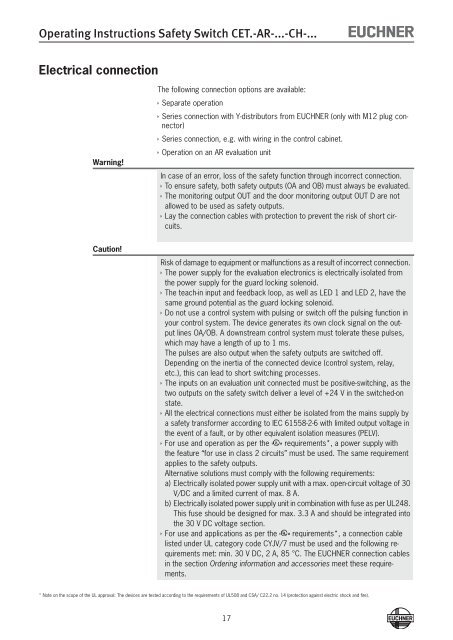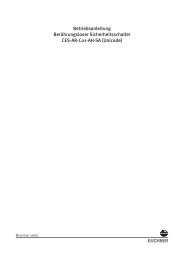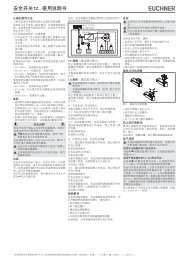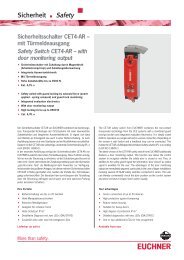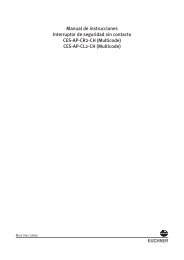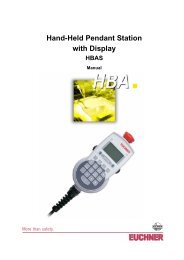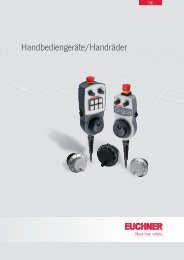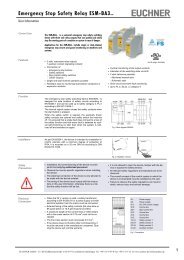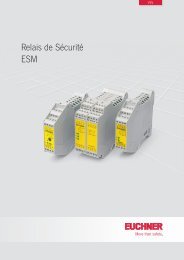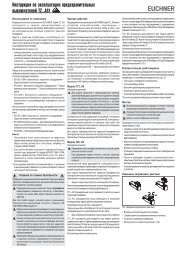Operating Instructions Non-Contact Safety Switch CET.-AR-...-CH ...
Operating Instructions Non-Contact Safety Switch CET.-AR-...-CH ...
Operating Instructions Non-Contact Safety Switch CET.-AR-...-CH ...
You also want an ePaper? Increase the reach of your titles
YUMPU automatically turns print PDFs into web optimized ePapers that Google loves.
<strong>Operating</strong> <strong>Instructions</strong> <strong>Safety</strong> <strong>Switch</strong> <strong>CET</strong>.-<strong>AR</strong>-...-<strong>CH</strong>-...<br />
Electrical connection<br />
Warning!<br />
The following connection options are available:<br />
ÌÌSeparate operation<br />
ÌÌSeries connection with Y-distributors from EU<strong>CH</strong>NER (only with M12 plug connector)<br />
ÌÌSeries connection, e.g. with wiring in the control cabinet.<br />
ÌÌOperation on an <strong>AR</strong> evaluation unit<br />
In case of an error, loss of the safety function through incorrect connection.<br />
ÌÌTo ensure safety, both safety outputs (OA and OB) must always be evaluated.<br />
ÌÌThe monitoring output OUT and the door monitoring output OUT D are not<br />
allowed to be used as safety outputs.<br />
ÌÌLay the connection cables with protection to prevent the risk of short circuits.<br />
Caution!<br />
Risk of damage to equipment or malfunctions as a result of incorrect connection.<br />
ÌÌThe power supply for the evaluation electronics is electrically isolated from<br />
the power supply for the guard locking solenoid.<br />
ÌÌThe teach-in input and feedback loop, as well as LED 1 and LED 2, have the<br />
same ground potential as the guard locking solenoid.<br />
ÌÌDo not use a control system with pulsing or switch off the pulsing function in<br />
your control system. The device generates its own clock signal on the output<br />
lines OA/OB. A downstream control system must tolerate these pulses,<br />
which may have a length of up to 1 ms.<br />
The pulses are also output when the safety outputs are switched off.<br />
Depending on the inertia of the connected device (control system, relay,<br />
etc.), this can lead to short switching processes.<br />
ÌÌThe inputs on an evaluation unit connected must be positive-switching, as the<br />
two outputs on the safety switch deliver a level of +24 V in the switched-on<br />
state.<br />
ÌÌAll the electrical connections must either be isolated from the mains supply by<br />
a safety transformer according to IEC 61558-2-6 with limited output voltage in<br />
the event of a fault, or by other equivalent isolation measures (PELV).<br />
ÌÌFor use and operation as per the requirements*, a power supply with<br />
the feature “for use in class 2 circuits” must be used. The same requirement<br />
applies to the safety outputs.<br />
Alternative solutions must comply with the following requirements:<br />
a) Electrically isolated power supply unit with a max. open-circuit voltage of 30<br />
V/DC and a limited current of max. 8 A.<br />
b) Electrically isolated power supply unit in combination with fuse as per UL248.<br />
This fuse should be designed for max. 3.3 A and should be integrated into<br />
the 30 V DC voltage section.<br />
ÌÌFor use and applications as per the requirements*, a connection cable<br />
listed under UL category code CYJV/7 must be used and the following requirements<br />
met: min. 30 V DC, 2 A, 85 °C. The EU<strong>CH</strong>NER connection cables<br />
in the section Ordering information and accessories meet these requirements.<br />
* Note on the scope of the UL approval: The devices are tested according to the requirements of UL508 and CSA/ C22.2 no. 14 (protection against electric shock and fire).<br />
17


